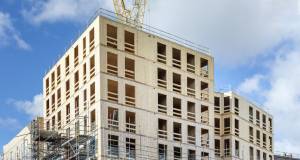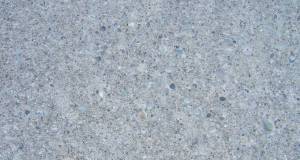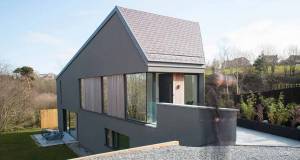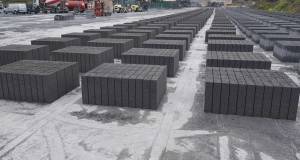Lime hemp

Environmental impacts from buildings and in particular the contribution of carbon emissions from energy use in buildings to global warming is increasingly being highlighted as an issue of critical importance, growing political focus and industry challenge. Here in Ireland we are seeing the emergence of a sustainable design and building sector within the construction industry with many aspects thereof already showing signs of moving to mainstream practice.
Against this background we are seeing the development of Lime-hemp as a bio composite construction material with serious ecological and energy advantages. Patrick Daly, lecturer in Environmental Design at DIT Bolton St. asks if this is the environmental material of the future and explores its mainstreaming potential.
Considering the rather small size of the environmental building movement, it is interesting to discover that there are various camps and groupings within it, with some notable debate taking place between them. The most striking difference of all has often been between the ‘energy’ and ‘ecology’ wings, or to give an example, between the ‘energy nuts’, as a well know eco materials professor once referred to ‘them’, and the ‘hairy shirts brigade’ as another professor of equal standing likewise countered. The gap between such colleagues is often wide, is generally counter productive and needs to be bridged.
One such area of bridge building is the world of bio composites and in particular the development of lime hemp as a bio composites material, which has serious ecological and energy credentials, and is attracting interest from both wings of the environmental movement, not only those concerned about toxicity, embodied energy and so on. but and also those interested in U values and thermal performance. Indeed lime hemp’s carbon sequestration capability should be music to the ears of any ‘energy enthusiast’ as carbon reduction is often a prime driver of the energy lobby.
However it is not just the excellent environmental credentials of this material that are of interest, but also its versatility and potential to integrate into current building systems and solutions. It is this potential to mainstream that is most significant and could multiply the positive environmental benefits exponentially.
Lime
Lime has been used as a construction material for thousands of years. Some of the first cement uses were actually lime-cements with examples of lime concretes being used in Rome for both civil and building projects including, for example, various ‘limecrete’ specifications used within the walls and roof of the Pantheon.
There was a decline in lime cements following the fall of the Roman Empire, with the next main resurgence of lime cements occurring during the 18th Century. Major building and civil projects were undertaken across Europe during this period with extensive research being undertaken into the properties, mixes, specification and techniques of lime cements, such that by early 19th century lime was in extensive use.

Hemp, one of the strongest natural fibres, is a renewable material, with a fast growing season and potential for 3 harvests per annum
However the development of portland cement in 1824 by Joseph Aspdin was to lead to a decline in lime use and specification, particularly for structural use, and eventually even for renders and mortars, which in the UK and Ireland have also become dominated by portland cements.
Despite the decline of lime production, specification and use in the industry, there are aspects and properties of lime that are very positive in environmental terms, which may be critical to its resurgence, in particular its capacity to enable bio material composites.
Lime has many environmental positives, being a natural material, which in processing has lower embodied energy and carbon values than portland cement. It is vapour permeable and hygroscopic, the principle properties of breathability. It has ‘self healing’ properties and does not require movement joints. Lime can be used as a render, plaster, mortar and even as a cement agent under certain load and setting conditions, and lime mortar can allow recycling of brick and blocks at end of use. Lime has the potential to be harvested and processed on a local level and there are many examples of historical local lime sources enabling production in Ireland. Crucially, lime can act as an enabler of bio materials such as hemp.
Hemp
Hemp has been grown and used for a wide range of products by civilisations for 10,000 years. During the ‘age of discovery’ it effectively powered the naval forces in their colonial expansions as it was a principle material for sails, ropes and rigging, and many colonies were mandated to grow and produce hemp. In the late 1800’s hemp was being used in the early plastics industry but was replaced by petro-oil based products and soon came under significant decline following its association with the cannabis ban in many countries thereafter.
However in recent decades hemp has been making a significant recovery as an industrial crop with literally thousands of applications, from horse bedding, to insulation, to oils and even to being used as a fibre in BMW door panels! Hemp has attractive environmental credentials, being a fully recyclable natural product, producing no toxic by-products, and having a low impact processing system.
In the construction industry hemp has been used as an insulation quilt, and there have been recent studies into using it in strand board technologies. However its incorporation into a lime hemp mix as a bio aggregate for structural block work and non load-bearing infill have presented new opportunities, which in addition to its ecological benefits includes thermal efficiency.

Evidence in the UK from a BRE study at Haverhill Housing Project indicates that the walls of a Lime Hemp house, performed at a better actual U Value than the notional calculation
Hemp, one of the strongest natural fibres, is a natural and renewable material, with a fast growing season (up to 3 meters in 4 months), and potential for 3 harvests per annum, the processing of which is non toxic, with low environmental impact. The hemp plant produces multiple resources including oils for foods and cosmetics but the ‘shiv’—typically a waste product—is an ideal material for a bio aggregate with a low embodied energy value compared to gravel based aggregates.
Lime hemp Bio Composite Construction
Lime and hemp mixtures have been recently pioneered in Europe by ecological builders in France, with interest and take up emerging both in Ireland and the UK. Coming from a craft base these eco projects have explored the potential of the material via low tech and low skills solutions such as an infill mix manually tamped into a simple shuttering around a timber stub frame.
In addition to the excellent properties of each material, both of which have attractive environmental features, the material synergy between hemp and lime is excellent. When used in timber frame the wood provides load bearing capacity, the hemp acts as a bio aggregate—which like the wood gives further carbon sequestration—and the lime acts as a binder, which also protects the bio elements via its high PH level, thus avoiding the need for timber preservatives.
Indeed it is this enabling capacity of the lime that is pivotal to the successful combination and facilitates the use of hemp, which replaces a gravel based aggregate, using the ‘shiv’ waste of the hemp product, which being a bio material significantly increases the volume of carbon stored in the construction, one of its unique environmental benefits.
Carbon Sequestration
A unique result of combining lime and hemp is their ability to act as a carbon sink. Data from Lime Technology Ltd in the UK proposes that 50 Kg of CO2 can be locked up per 1 M2 of lime hemp walling, and they estimate that a typical lime hemp house equates to roughly 50 tonnes of carbon per house, which in addition to embodied energy savings is a critical one-off carbon saving. Given this, one can envisage the environmental positives of such a construction being mainstream in the Irish context.
Air Permeability
Although not tested in the Haverhill Project (discussed later), proponents such as Lime Technology argue that there are potential air permeability benefits by the nature of lime hemp’s monolithic construction, (spray or infill around openings etc.) and plastering, rendering finishes. .Comparisons to traditional build houses using air pressure testing would be insightful here.
Ecological Benefits
Lime hemp construction also presents important vapour permeable and hygroscopic properties, ensuring that constructions can be breathable. The lime can also provide protection to timber members, thus avoiding toxic chemical treatment, and lime hemp is also fire and vermin resistant.
Thermal Performance
Evidence in the UK from a BRE study at Haverhill Housing Project indicates that the walls of a lime hemp house, performed at a better (lower) actual U value than the notional calculation. The monolithic nature of the wall construction in and of itself should also lead to lower thermal bridging, which may also have been a factor in the higher performances measured at Haverhill. Again further research here is required.

The Centre for Alternative Technology (CAT) is now seeking to use 'Hemcrete TM' in a spray application at the new CAT WISE (Wales Institute for Sustainbable Education)
Haverhill Housing BRE
Suffolk Housing Society undertook an explorative build and research project in the form of two lime hemp houses which included extensive research carried out by BRE. The project involved the construction of two lime-hemp homes, one occupied and one left as a control house, which was compared to an equivalent block brick traditional house.
The housing society was keen to promote and explore the environmental benefits of the construction, the results of which has provided keen interest from other parties. Environmental benefits envisaged were listed as follows:
Thermal Results:
Some of most relevant aspects of the findings of the report relate to the thermal performance of the two test houses, which indicate that the lime hemp walls exceeded their notional design U Value.
On the basis of notional design the walls of the lime hemp houses had a poorer (higher) U Value (below UK Regulations) and the lime hemp houses had a resulting SAP rating of 77 compared to the Block Brick cavity house with a rating of 87, which met part L. This should have meant that the lime hemp house had lower temperatures and higher energy in use, but in fact the opposite turned out to be the case.
The implication of this is that the thermal performance of the Lime hemp construction was superior to its neighbouring brick block house, and that this was not reflected in the actual U Value or SAP calculations. This may have been due in part to the monolithic nature of the construction and the infill method, which should equate to reduced thermal bridging and lower air leakage rates. Likewise it may also have meant that the actual U value was greater than the notional one. The latter is supported by evidence that steady state U value assumptions do not reflect actual heat transfer, (which is multi directional) nor do they adequately take due account of thermal mass. There is debate in the industry regarding U value calculation methodologies, and questions regarding how effective the current methodology is, particularly in relation to thermal mass and the cyclical heat flows in walls.
Mainsteaming:
The Haverhill project also raised issues about mainstreaming such construction including programme and higher labour costs associated with the build system of shuttering, manual infill and tamping. However, given that it was only two houses and a first for the contractor such issues may be overcome with projects giving economies of scale.
The concluding comments in the report by Suffolk Housing Society itself, raises questions and challenges about the need for mainstreaming of the method, suggesting industry needs to find technical solutions to deliver such an environmentally positive construction approach more effectively and cost efficiently to expand its take up.
Economy of scale is a critical part of what is needed to integrate these materials and construction methods into the mainstream and it would be welcome to see architects, developers and contractors who are willing to integrate this material and construction techniques into medium to large scale projects.
U Values
Taking a thermal conductivity figure for lightly tamped lime hemp mixtures of 0.09 W/mK (provided by Lime Technology), the following ‘notional’ U values are achievable for a 100 mm stud encased in lime hemp mix with internal lime plaster and external lime render (these are approximate figures, subject to mix, spec, and so on):
300 mm wall 0.29 W/m2K
400 mm wall 0.22 W/m2K
500 mm wall 0.18 W/m2K
While it is clear that lime hemp construction in a single composite wall is proving to meet or surpass building regulation U values, low energy practitioners will want to know just how low the U values can go and if it can achieve super insulation values, such as the Passive House standard of 0.15 W/m2K or even lower at 0.1 W/m2K.
To meet this standard low energy designers have had to rely on significant widths of insulation in the envelope and often need to resort to the higher performance insulations, (with higher embodied energy and toxicity issues) to achieve the required performance, while the more crafts based ecological materials movement has in general focused on meeting building regulations or marginal improvements thereon.
In order to achieve these standards a lime hemp wall would need to be 600mm to 900mm wide. Despite most Passive Houses having thicker than traditional wall construction widths, (approx 400 - 500 mm), double this is rather excessive.
One could reduce this to more acceptable levels by introducing an insulative layer; however one must keep in mind that such notional U values are not reflective of the actual or ‘effective’ transfer of heat, and case studies such as Haverhill seem to suggest that lime hemp walls are behaving more akin to a thermally massive wall. Clearly further research is needed here, but it may be that lime hemp bio composites could act as a hybrid between ultra lightweight and heavyweight envelopes. If so it may present other interesting energy moderation and control benefits.
Mainstreaming
Given the above it is heartening to note that there are already explorations and developments to bring lime hemp construction into the mainstream. Companies such as Lime technology in the UK, lead by Ian Pritchett, are exploring using this material in a number of mainstream construction applications including block and spray application. Given their existing specialist knowledge in traditional lime buildings, and having developed a mainstream lime renderings and mortars capability, Lime Technology are well positioned to exploit and integrate this material into the mainstream.
Lime hemp Build Systems
Lime Technology Ltd have already developed a block making capability and are involved in a major on site block production and assembly project in the 8000 sq m Adnams green warehouse project, involving lime chalk masonry diaphragm walls filled with hemp lime mix.

Lime Technology LTD have been involved in a major onsite block production and assembly project in the 8000 sq m Adnams green warehouse project, involving Lime Chalk Masonry diaphragm walls filled with Hemp Lime mix
They are also developing a spay application technique for a lime hemp mix, which can be sprayed in a single application into a timber frame lined one side. This is envisaged to give rapid construction time, and has been tested with success on their new premises in the UK.
The Centre for Alternative Technology (CAT) is now seeking to use ‘Hemcrete TM’ in a spray application at the new CAT WISE (Wales Institute for Sustainable Education) facility, which is a significant scale building, involving a 200-seat lecture theatre, workshops, seminar rooms, restaurant, offices, student accommodation and laboratory. The proposal to use a timber frame structure with a 480mm thick wall built up from a single spray applied lime hemp mix into a part shuttered wall all finished with lime plasters and renders.
The scale of the Adnams and CAT WISE projects should be noted, as they clearly demonstrate that this material and technology is moving into a new league.
Here in Ireland there are a number of one off housing projects and some small scale settlements using and proposing lime hemp. One ambitious project is the Irish Rural Link ENLIVEN project based in the Midlands, which is seeking to use lime hemp bio composites for an envisioned 10 sustainable village developments.
As can be seen from these projects lime hemp is moving from its crafts base and quickly developing mainstream capabilities, with masonry, cast in situ and on site spray applications, which could enable high volume use of the material. ‘Pre Cast’ possibilities are clearly there and give the material further mainstreaming possibilities. Developments are currently underway to provide bio composite, pre-cast, non load bearing panels for an industrial application in the UK.
However technical and construction aspects are only some of the challenges to be overcome to enable lime hemp to integrate into the mainstream, and there are regulatory issues which will need to be addressed.
Regulatory Context
The Irish regulatory context is different to the UK principally in terms of compliance with building regulations, which in Ireland is primarily undertaken and provided by the designers and builders. In this context some designers are taking the lead and open to specification of lime hemp, however in general, given their ‘compliance obligations’, designers are heavily reliant on certification of products and for entire construction systems, the latter of which requires a national certificate in the form of the Irish Agrément certificate.
Insurance issues are also reliant on certification and builder guarantee schemes may not accept architects’ certificates of compliance for non standard / non certified construction, requiring national certificates instead. Such practice has tended to limit pioneering construction to small scale or one off housing. Recently ‘Premier Guarantee’ has provided insurance to projects with innovative aspects, which is a welcome development.
In addition to the above the Department of the Environment sets a ‘durability test’ for any form of social housing grant aid or tax relief, which requires an Irish Agrément certificate for construction systems, again limiting innovation, which in the UK context would have stopped the Haverhill Project from getting off the ground.
Growing Aggregate
The emergence of a lime hemp bio composite industry in Ireland is quite a challenge and will involve many stakeholders with a range of interesting wider social and economic spin offs.
There is some potential for local lime production, but it will be important for any such developments to have strong material quality and control aspects to ensure standards in this emerging industry. We will more likely see a significant benefit to the agricultural sector in the form of hemp growing and harvesting which, given the decline in farming and the need for alternative crops, will be a welcome spin off. Local hemp grower networks and markets will facilitate the development of regional processing plants, which is currently underway in the UK.
The Future is Bio Composite
Lime hemp bio composite presents as a remarkable building material and construction method. Its combined energy and ecological advantages give it a unique and strong place within the various specification options open to environmental designers and builders. In particular its low embodied energy and its ability to sequestrate significant amounts of carbon is an exceptional sustainable quality, especially for super low energy buildings, where energy reductions and carbon savings from energy in use have already been optimised.
While it may reach limits in terms of low U values, it has the capacity to integrate with bio insulations to achieve the best standards. In addition to this, its thermal properties may prove superior in terms of ‘effective’ U values, thermal performance and control in buildings form reduced bridging, air tightness and thermal mass advantages.
The mainstreaming of this product has just begun, notably not by supplanting existing systems but by integrating into them, which, given its compatibility with both timber frame and masonry build, is an exciting aspect.
In my opinion lime hemp will become a significant and common mainstream application, and as it does there will be significant environmental benefits as well as spin offs in manufacturing, processing and agriculture. The future is bio composite.
Patrick Daly
Patrick Daly lectures in Environmental Design in the School of Architecture, Dublin Institute of Technology, Bolton St, where he has developed new modules in low energy and environmental impact design and is involved in a number of sustainable design initiatives.
Patrick has carried out research into lime hemp construction and is actively promoting take up of the material in Ireland. He runs his own environmental design consultancy and is involved in the design of a number of super low energy houses using lime hemp construction.
If you would like further information or advice on lime hemp construction please contact Patrick at pd(at)patrickdaly.net or call 01 4536306
- Articles
- Design Approaches
- Lime Hemp lime
- hemp
- environmental design
- composite construction
- carbon
- permeability
- thermal
- cement
- haverhill
- U value
Related items
-
 Up to 11
Up to 11 -
 Ecocem announces cement breakthrough to cut CO2 by 70 per cent
Ecocem announces cement breakthrough to cut CO2 by 70 per cent -
 Kilsaran launch lower carbon cement with CarbonCure
Kilsaran launch lower carbon cement with CarbonCure -
 Ecocem gets €22m investment from Bill Gates's climate fund
Ecocem gets €22m investment from Bill Gates's climate fund -
 Strong demand for GGBS from Irish market
Strong demand for GGBS from Irish market -
 Mannok announces new product names after rebrand
Mannok announces new product names after rebrand -
 Towards greener homes — the role of green finance
Towards greener homes — the role of green finance -
 The PH+ guide to greener concrete - reducing the climate impact of cement and concrete in buildings
The PH+ guide to greener concrete - reducing the climate impact of cement and concrete in buildings -
 Steeply sustainable - Low carbon passive design wonder on impossible Cork site
Steeply sustainable - Low carbon passive design wonder on impossible Cork site -
 Low carbon concrete blocks now available in Ireland
Low carbon concrete blocks now available in Ireland -
 Focus on whole build systems, not products - NBT
Focus on whole build systems, not products - NBT -
 International - Issue 29
International - Issue 29













